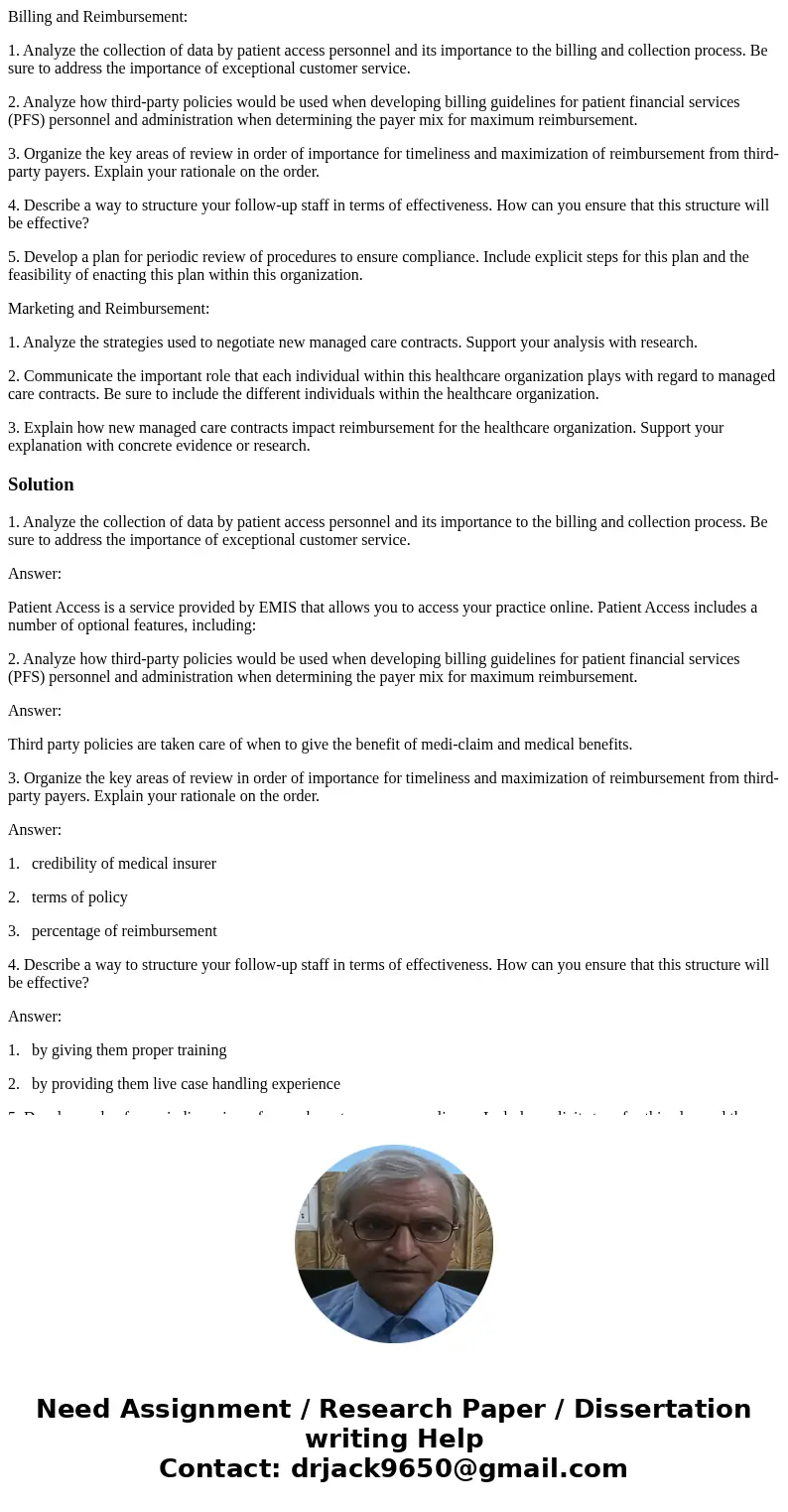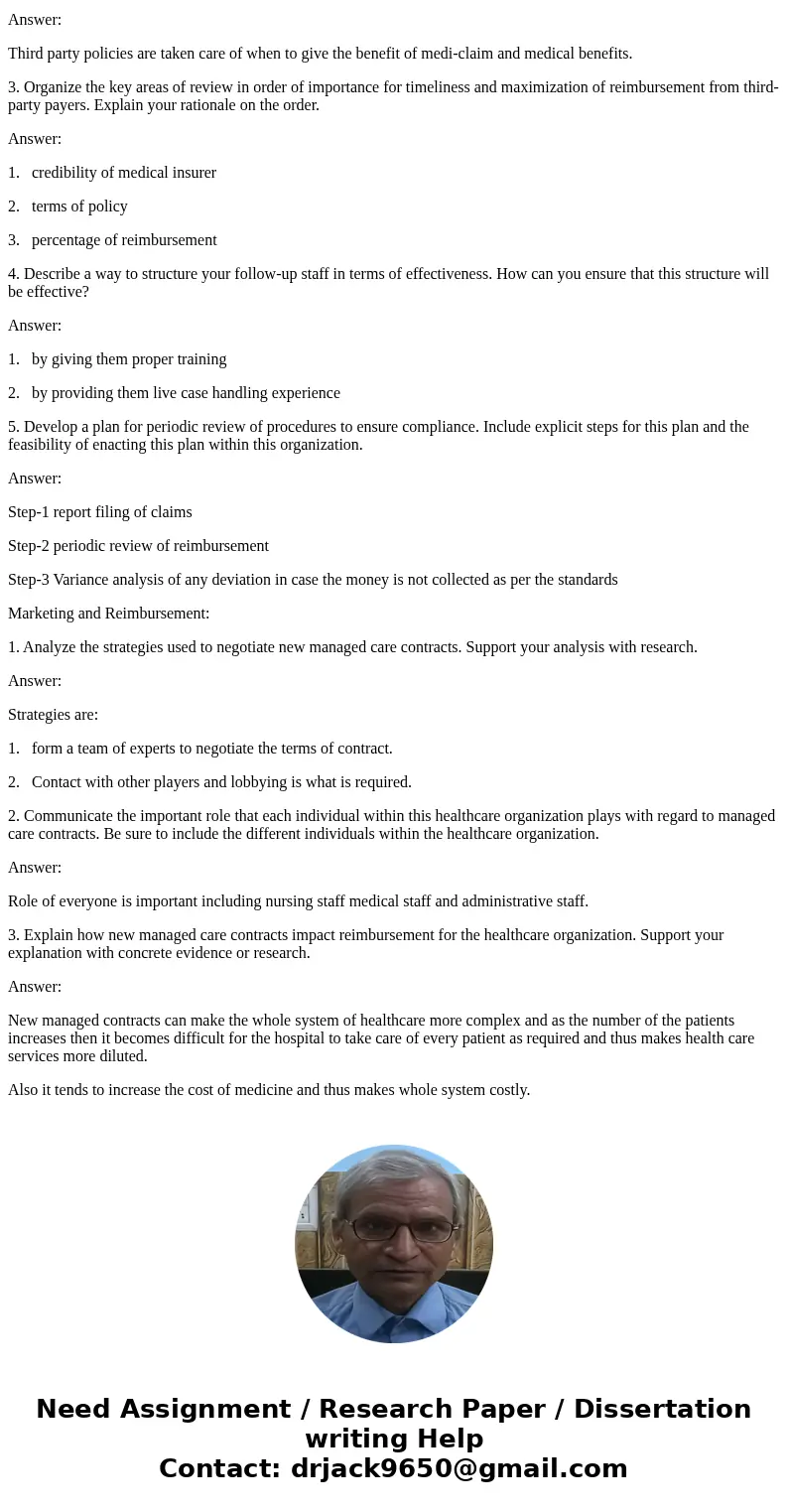Billing and Reimbursement 1 Analyze the collection of data b
Billing and Reimbursement:
1. Analyze the collection of data by patient access personnel and its importance to the billing and collection process. Be sure to address the importance of exceptional customer service.
2. Analyze how third-party policies would be used when developing billing guidelines for patient financial services (PFS) personnel and administration when determining the payer mix for maximum reimbursement.
3. Organize the key areas of review in order of importance for timeliness and maximization of reimbursement from third-party payers. Explain your rationale on the order.
4. Describe a way to structure your follow-up staff in terms of effectiveness. How can you ensure that this structure will be effective?
5. Develop a plan for periodic review of procedures to ensure compliance. Include explicit steps for this plan and the feasibility of enacting this plan within this organization.
Marketing and Reimbursement:
1. Analyze the strategies used to negotiate new managed care contracts. Support your analysis with research.
2. Communicate the important role that each individual within this healthcare organization plays with regard to managed care contracts. Be sure to include the different individuals within the healthcare organization.
3. Explain how new managed care contracts impact reimbursement for the healthcare organization. Support your explanation with concrete evidence or research.
Solution
1. Analyze the collection of data by patient access personnel and its importance to the billing and collection process. Be sure to address the importance of exceptional customer service.
Answer:
Patient Access is a service provided by EMIS that allows you to access your practice online. Patient Access includes a number of optional features, including:
2. Analyze how third-party policies would be used when developing billing guidelines for patient financial services (PFS) personnel and administration when determining the payer mix for maximum reimbursement.
Answer:
Third party policies are taken care of when to give the benefit of medi-claim and medical benefits.
3. Organize the key areas of review in order of importance for timeliness and maximization of reimbursement from third-party payers. Explain your rationale on the order.
Answer:
1. credibility of medical insurer
2. terms of policy
3. percentage of reimbursement
4. Describe a way to structure your follow-up staff in terms of effectiveness. How can you ensure that this structure will be effective?
Answer:
1. by giving them proper training
2. by providing them live case handling experience
5. Develop a plan for periodic review of procedures to ensure compliance. Include explicit steps for this plan and the feasibility of enacting this plan within this organization.
Answer:
Step-1 report filing of claims
Step-2 periodic review of reimbursement
Step-3 Variance analysis of any deviation in case the money is not collected as per the standards
Marketing and Reimbursement:
1. Analyze the strategies used to negotiate new managed care contracts. Support your analysis with research.
Answer:
Strategies are:
1. form a team of experts to negotiate the terms of contract.
2. Contact with other players and lobbying is what is required.
2. Communicate the important role that each individual within this healthcare organization plays with regard to managed care contracts. Be sure to include the different individuals within the healthcare organization.
Answer:
Role of everyone is important including nursing staff medical staff and administrative staff.
3. Explain how new managed care contracts impact reimbursement for the healthcare organization. Support your explanation with concrete evidence or research.
Answer:
New managed contracts can make the whole system of healthcare more complex and as the number of the patients increases then it becomes difficult for the hospital to take care of every patient as required and thus makes health care services more diluted.
Also it tends to increase the cost of medicine and thus makes whole system costly.


 Homework Sourse
Homework Sourse